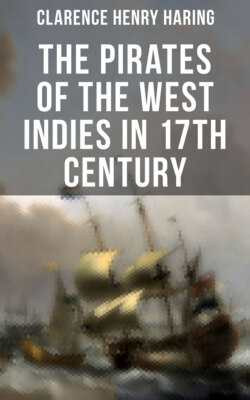THE PIRATES OF THE WEST INDIES IN 17TH CENTURY

Реклама. ООО «ЛитРес», ИНН: 7719571260.
Оглавление
Clarence Henry Haring. THE PIRATES OF THE WEST INDIES IN 17TH CENTURY
THE PIRATES OF THE WEST INDIES IN 17TH CENTURY
Reading suggestions
Preface
Chapter I. Introductory
I.The Spanish Colonial System
II. The Freebooters of the Sixteenth Century
Chapter II. The Beginnings of the Buccaneers
Chapter III. The Conquest of Jamaica
Chapter IV. Tortuga—1655-1664
Chapter V. Porto Bello and Panama
Chapter VI. The Government Suppresses the Buccaneers
Chapter VII. The Buccaneers Turn Pirate
Appendix I
Appendix II
Sources and Bibliography
Отрывок из книги
Clarence Henry Haring
Preface
.....
The galleons generally consisted of from five to eight war-vessels carrying from forty to fifty guns, together with several smaller, faster boats called "pataches," and a fleet of merchantmen varying in number in different years. In the time of Philip II. often as many as forty ships supplied Cartagena and Porto Bello, but in succeeding reigns, although the population of the Indies was rapidly increasing, American commerce fell off so sadly that eight or ten were sufficient for all the trade of South and Central America. The general of the galleons, on his departure, received from the Council of the Indies three sealed packets. The first, opened at the Canaries, contained the name of the island in the West Indies at which the fleet was first to call. The second was unsealed after the galleons arrived at Cartagena, and contained instructions for the fleet to return in the same year or to winter in America. In the third, left unopened until the fleet had emerged from the Bahama Channel on the homeward voyage, were orders for the route to the Azores and the islands they should touch in passing, usually Corvo and Flores or Santa Maria.14
The course of the galleons from San Lucar was south-west to Teneriffe on the African coast, and thence to the Grand Canary to call for provisions—considered in all a run of eight days. From the Canaries one of the pataches sailed on alone to Cartagena and Porto Bello, carrying letters and packets from the Court and announcing the coming of the fleet. If the two fleets sailed together, they steered south-west from the Canaries to about the latitude of Deseada, 15' 30", and then catching the Trade winds continued due west, rarely changing a sail until Deseada or one of the other West Indian islands was sighted. From Deseada the galleons steered an easy course to Cape de la Vela, and thence to Cartagena. When the galleons sailed from Spain alone, however, they entered the Caribbean Sea by the channel between Tobago and Trinidad, afterwards named the Galleons' Passage. Opposite Margarita a second patache left the fleet to visit the island and collect the royal revenues, although after the exhaustion of the pearl fisheries the island lost most of its importance. As the fleet advanced into regions where more security was felt, merchant ships too, which were intended to unload and trade on the coasts they were passing, detached themselves during the night and made for Caracas, Santa Marta or Maracaibo to get silver, cochineal, leather and cocoa. The Margarita patache, meanwhile, had sailed on to Cumana and Caracas to receive there the king's treasure, mostly paid in cocoa, the real currency of the country, and thence proceeded to Cartagena to rejoin the galleons.15
.....